
Concept explainers
(a)
Interpretation:
The name of the following alkene is to be determined.

Concept Introduction :
The
(a)
Answer to Problem 163AE
The name of the given alkene is 2 − methyl − 1 butene.
Explanation of Solution
The structure of the compound is given as follows:

From the above structure, it can be seen that there are four carbon atoms present in the principle chain of the compound and the atoms are bonded with double bond. Hence, the compound is known as alkene. The double bond of the structure is present at the position one that is the lowest possible number. The substituent methyl of the structure is present at second carbon (C2). Therefore, the name of the compound is 2 − methyl − 1 butene. The representation of the carbon position in a structure is given below −

(b)
Interpretation:
The name of the following alkene is to be determined.

Concept Introduction :
The unsaturated hydrocarbon is a group of hydrocarbons and also known as alkenes or alkynes. They are unsaturated because of the presence of triple or double bonds. Alkynes or hydrocarbons consist of at least one triple bond while alkenes consist of at least one carbon-carbon double bond in the main chain.
(b)
Answer to Problem 163AE
The name of the given alkenes is 2, 4 − dimethyl − 1, 4 − pentadiene.
Explanation of Solution
The structure of the given compound is −

From the above structure, it can be seen that there are five carbon atoms are present in the principle chain of the compound and the atoms are bonded with two double bonds. Hence, the compound is known as alkene. The double of the structure is present at the position one and position four and these are the lowest possible numbers. The methyl substituent of the structure is present at second carbon (C2) and third carbon (C3). Therefore, the name of the compound is 2, 4 − dimethyl − 1, 4 − pentadiene. The representation of the carbon position in a structure is given below −

(c)
Interpretation:
The name of the following alkene is to be determined
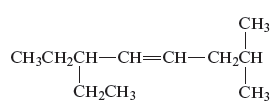
Concept Introduction :
The unsaturated hydrocarbon is a group of hydrocarbons and also known as alkenes or alkynes. They are unsaturated because of the presence of triple or double bonds. Alkynes or hydrocarbons consist of at least one triple bond while alkenes consist of at least one carbon-carbon double bond in the main chain.
(c)
Answer to Problem 163AE
The name of the given alkene is 6 − ethyl − 2 − methyl − 4 octene.
Explanation of Solution
The structure of the given compound is −
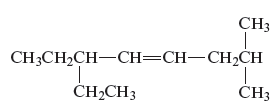
From the above structure, it can be seen that there are eight carbon atoms are present in the principle chain of the compound and there is a double bond in the main chain. Hence, the compound is known as alkene. The substituent ethyl is present at the sixth carbon (C6) atom and the substituent methyl is present at the second carbon atom (C2). Therefore, the name of the compound is 6 − ethyl − 2 − methyl − 4 octene. The representation of the carbon position in a structure is given below −
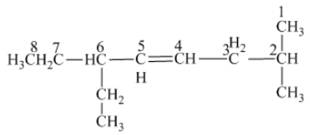
(d)
Interpretation:
The name of the following alkyne is to be determined.

Concept Introduction :
The unsaturated hydrocarbon is a group of hydrocarbons and also known as alkenes or alkynes. They are unsaturated because of the presence of triple or double bonds. Alkynes or hydrocarbons consist of at least one triple bond while alkenes consist of at least one carbon-carbon double bond in the main chain.
(d)
Answer to Problem 163AE
The name of the given alkyne is 3 − bromo-1-heptyne.
Explanation of Solution
The structure of the given compound is −

From the above structure, it can be seen that there are seven carbon atoms present in the principle chain of the compound and the atoms are bonded with triple bonds. Hence, the compound is known as alkyne. The triple bond of the structure is present at position one that is lowest possible number. The substituent bromine of the structure is present at third carbon (C3) position. Therefore, the name of the compound is 3 − bromo − 1 − heptyne. The representation of the carbon position in a structure is given below −

(e)
Interpretation:
The name of the following alkyne is to be determined
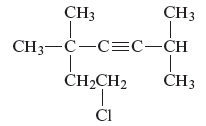
Concept Introduction :
The unsaturated hydrocarbon is a group of hydrocarbons and also known as alkenes or alkynes. They are unsaturated because of the presence of triple or double bonds. Alkynes or hydrocarbons consist of at least one triple bond while alkenes consist of at least one carbon-carbon double bond in the main chain.
(e)
Answer to Problem 163AE
The name of the given alkyne is 7 − chloro − 2, 5,5 − trimethyl − 3 − heptyne.
Explanation of Solution
The structure of the given compound is −
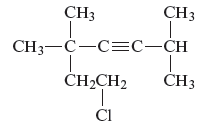
From the above structure, it can be seen that there are six carbon atoms are present in the principle chain of the compound and the atoms are bonded with triple bonds. Hence, the compound is known as alkynes. The triple bond of the structure is present at position three that is lowest possible number. The two methyl substituents of the structure are present at fifth carbon (C5) position and one methyl substituent is present at second carbon (C2) position. The other chlorine substituent is present at seventh carbon position (C7). Therefore, the name of the compound is 7 − chloro − 2, 5,5 − trimethyl − 3 − heptyne. The representation of the carbon position in a structure is given below −
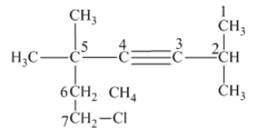
(f)
Interpretation:
The name of the following alkyne is to be determined
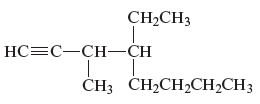
Concept Introduction:
The unsaturated hydrocarbon is a group of hydrocarbons and also known as alkenes or alkynes. This structure is formed because of the presence of triple or double bonds. Alkynes or hydrocarbons consists at least triple bond while alkynes consist at least one carbon-carbon double bon in the main chain.
(f)
Answer to Problem 163AE
The name of the given alkyne is 4 − ethyl − 3 − methyl − 1 − octyne.
Explanation of Solution
The structure of the given compound is −
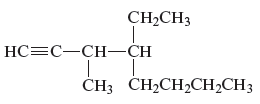
From the above structure, it can be seen that there are eight carbon atoms are present in the principle chain of the compound and the atoms are bonded with triple bonds. Hence, the compound is known as alkynes. The triple bond of the structure is present at position one that is lowest possible number. The methyl substituent of the structure is present at third carbon (C3) position and one ethyl substituent is present at fourth carbon (C4) position. Therefore, the name of the compound is 4 − ethyl − 3 − methyl − 1 − octyne. The representation of the carbon position in a structure is given below −
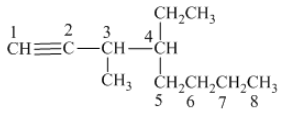
Want to see more full solutions like this?
Chapter 21 Solutions
EBK CHEMICAL PRINCIPLES
- The reaction of what nucleophile and substrate is represented by the following transition state? CH3 CH3O -Br อ δ CH3 Methanol with 2-bromopropane Methanol with 1-bromopropane Methoxide with 1-bromopropane Methoxide with 2-bromopropanearrow_forwardWhat is the stepwise mechanism for this reaction?arrow_forward32. Consider a two-state system in which the low energy level is 300 J mol 1 and the higher energy level is 800 J mol 1, and the temperature is 300 K. Find the population of each level. Hint: Pay attention to your units. A. What is the partition function for this system? B. What are the populations of each level? Now instead, consider a system with energy levels of 0 J mol C. Now what is the partition function? D. And what are the populations of the two levels? E. Finally, repeat the second calculation at 500 K. and 500 J mol 1 at 300 K. F. What do you notice about the populations as you increase the temperature? At what temperature would you expect the states to have equal populations?arrow_forward
- 30. We will derive the forms of the molecular partition functions for atoms and molecules shortly in class, but the partition function that describes the translational and rotational motion of a homonuclear diatomic molecule is given by Itrans (V,T) = = 2πmkBT h² V grot (T) 4π²IKBT h² Where h is Planck's constant and I is molecular moment of inertia. The overall partition function is qmolec Qtrans qrot. Find the energy, enthalpy, entropy, and Helmholtz free energy for the translational and rotational modes of 1 mole of oxygen molecules and 1 mole of iodine molecules at 50 K and at 300 K and with a volume of 1 m³. Here is some useful data: Moment of inertia: I2 I 7.46 x 10- 45 kg m² 2 O2 I 1.91 x 101 -46 kg m²arrow_forwardK for each reaction step. Be sure to account for all bond-breaking and bond-making steps. HI HaC Drawing Arrows! H3C OCH3 H 4 59°F Mostly sunny H CH3 HO O CH3 'C' CH3 Select to Add Arrows CH3 1 L H&C. OCH3 H H H H Select to Add Arrows Q Search Problem 30 of 20 H. H3C + :0: H CH3 CH3 20 H2C Undo Reset Done DELLarrow_forwardDraw the principal organic product of the following reaction.arrow_forward
- Curved arrows are used to illustrate the flow of electrons. Using the provided structures, draw the curved arrows that epict the mechanistic steps for the proton transfer between a hydronium ion and a pi bond. Draw any missing organic structures in the empty boxes. Be sure to account for all lone-pairs and charges as well as bond-breaking and bond-making steps. 2 56°F Mostly cloudy F1 Drawing Arrows > Q Search F2 F3 F4 ▷11 H. H : CI: H + Undo Reset Done DELLarrow_forwardCalculate the chemical shifts in 13C and 1H NMR for 4-chloropropiophenone ? Write structure and label hydrogens and carbons. Draw out the benzene ring structure when doing itarrow_forward1) Calculate the longest and shortest wavelengths in the Lyman and Paschen series. 2) Calculate the ionization energy of He* and L2+ ions in their ground states. 3) Calculate the kinetic energy of the electron emitted upon irradiation of a H-atom in ground state by a 50-nm radiation.arrow_forward
- Calculate the ionization energy of He+ and Li²+ ions in their ground states. Thannnxxxxx sirrr Ahehehehehejh27278283-4;*; shebehebbw $+$;$-;$-28283773838 hahhehdvaarrow_forwardPlleeaasseee solllveeee question 3 andd thankss sirr, don't solve it by AI plleeaasseee don't use AIarrow_forwardCalculate the chemical shifts in 13C and 1H NMR for 4-chloropropiophenone ? Write structure and label hydrogens and carbonsarrow_forward
- Chemistry: Matter and ChangeChemistryISBN:9780078746376Author:Dinah Zike, Laurel Dingrando, Nicholas Hainen, Cheryl WistromPublisher:Glencoe/McGraw-Hill School Pub Co
 Chemistry for Today: General, Organic, and Bioche...ChemistryISBN:9781305960060Author:Spencer L. Seager, Michael R. Slabaugh, Maren S. HansenPublisher:Cengage Learning
Chemistry for Today: General, Organic, and Bioche...ChemistryISBN:9781305960060Author:Spencer L. Seager, Michael R. Slabaugh, Maren S. HansenPublisher:Cengage Learning  Chemistry: Principles and PracticeChemistryISBN:9780534420123Author:Daniel L. Reger, Scott R. Goode, David W. Ball, Edward MercerPublisher:Cengage Learning
Chemistry: Principles and PracticeChemistryISBN:9780534420123Author:Daniel L. Reger, Scott R. Goode, David W. Ball, Edward MercerPublisher:Cengage Learning General, Organic, and Biological ChemistryChemistryISBN:9781285853918Author:H. Stephen StokerPublisher:Cengage Learning
General, Organic, and Biological ChemistryChemistryISBN:9781285853918Author:H. Stephen StokerPublisher:Cengage Learning Organic And Biological ChemistryChemistryISBN:9781305081079Author:STOKER, H. Stephen (howard Stephen)Publisher:Cengage Learning,
Organic And Biological ChemistryChemistryISBN:9781305081079Author:STOKER, H. Stephen (howard Stephen)Publisher:Cengage Learning,





